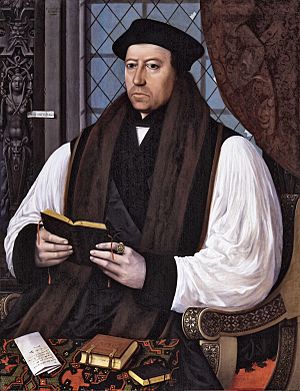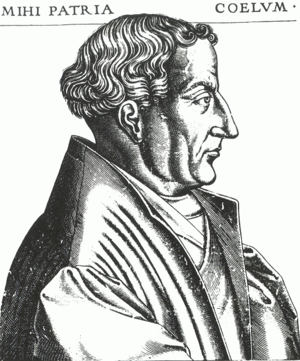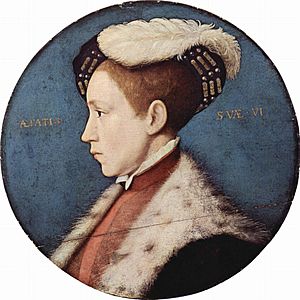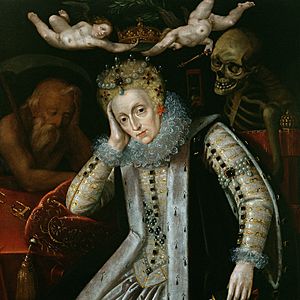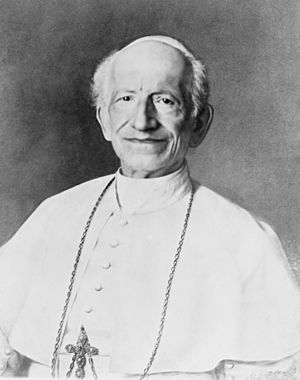Edwardine Ordinals facts for kids
The Edwardine Ordinals are two important books for the Church of England. They were mainly written by Thomas Cranmer and first published when Edward VI was king. The first one came out in 1550 and the second in 1552. These books were made to change how new priests, deacons, and bishops were chosen and welcomed into their roles. Before these books, the Church used older, more complicated ceremonies from the Middle Ages.
The 1550 ordinal was released after the first Book of Common Prayer in 1549. The 1552 ordinal came out with the second Book of Common Prayer. Both prayer books were also mostly put together by Cranmer. The Edwardine Ordinals were very important for how Anglican priests and bishops were chosen for hundreds of years. They helped change the idea of a priest from someone who mainly performed sacrifices to someone who mainly preached and taught. These books also caused some big arguments later on, especially about whether Anglican priests and bishops were truly recognized by the Catholic Church.
Contents
Old Ways of Ordaining Priests
Before the Edwardine Ordinals, the word ordinal didn't mean a book for choosing priests. It was a book used for daily prayers. The word ordinal for choosing priests only became common much later, in the 1600s.
Before the English Reformation, ceremonies for choosing priests, deacons, and bishops were found in books called pontificals. The most common ones were the Roman Pontifical and the Sarum Pontifical. These old ceremonies were a big topic of debate between the Catholic Church and the reformers. Some thought the old books were fine, while others, like the Anglicans, felt that important parts, like the laying on of hands by the bishop, were hidden or removed by other rituals.
The old French ordination ceremonies, which influenced the Roman ones, were very detailed but also had clear moments for choosing new priests. For example, when a bishop laid hands on a candidate for priesthood, he would clearly say it was "the blessing of the presbyterate." Anointing a priest's hand with holy oil was also part of these ceremonies.
By the 900s, English pontificals added a special prayer called a litany to the ordination ceremonies. These medieval books included ways to choose deacons, priests, and bishops. They also had ways to choose people for less important roles. Over time, these books started to focus more on giving new priests special clothes and items, like stoles, patens, and chalices. This was called the "tradition of elements." In 1439, Pope Eugene IV said this practice was a key part of choosing a priest. These old ceremonies were often complicated because different traditions were mixed together.
The First Edwardine Ordinal (1550)
When the Church of England separated from Rome during the English Reformation, Henry VIII ordered that any promises of obedience to the Pope be removed from the old pontificals. Some copies of these old books still show these changes. In 1547, it became allowed for clergy in the Church of England to marry. However, there wasn't a new book for choosing priests right away. For the first year after the 1549 Book of Common Prayer came out, the Church of England still used the old Sarum ordination ceremonies.
Martin Bucer, a German reformer who came to England in 1548, helped a lot. He had ideas about the role of priests from Germany and wrote a Latin book about ordination for the English reformers to study. Thomas Cranmer, the Archbishop of Canterbury and the main writer of the 1549 prayer book, performed an ordination in 1549 that followed the new ideas.
Parliament officially asked for a new ordinal on January 8, 1550, and it was approved on January 31. A group was set up to create the new book. Nicholas Heath, a Catholic bishop, was on this group but refused to approve the new book. He was then put in prison. The new book was mostly put together by Cranmer, using Bucer's ideas and some of his own. The ordinal was finished and published by March 25, 1550. It was printed separately from the prayer book and had a long title: A forme and maner of makyng and consecratyng of Archebisshopes, Bisshopes, Priestes and Deacons.
The 1550 ordinal was based on the old Sarum ceremonies, but it made them much simpler. It focused on the laying on of hands and special prayers, including the old hymn Veni Creator Spiritus. Also, the less important roles (minor orders) were completely removed. The book said that only deacons, priests, and bishops were needed, based on what the Bible and early Christian traditions taught. Candidates for deacon and priest also had to be examined, which was only done for bishops before.
The main parts of the ordination ceremony were put into a Holy Communion service. Like the old medieval ceremonies, these parts were spread throughout the service. The 1550 ordinal kept the tradition of giving a newly chosen priest certain items, but it added a Bible along with the paten and chalice.
Regular people could attend these ceremonies and even speak up if they knew a reason why someone should not be ordained. The 1550 ordinal also said that candidates should be educated and connected to their local community. This was sometimes hard in places like Wales, where English-speaking clergy had trouble talking to Welsh-speaking people. In Ireland, it was also difficult to introduce the new Anglican services because they weren't translated into the local language.
Catholic bishops in England did not like the 1550 ordinal. Nicholas Heath, who had accepted the 1549 prayer book, refused to accept the 1550 ordinal. He believed it weakened the Church of England's connection to the wider Christian Church. He was removed from his position and imprisoned, as was another Catholic bishop, Stephen Gardiner.
Choosing a Bishop in 1550
The way bishops were chosen in the 1550 ordinal was different from both the old Sarum Pontifical and Bucer's Latin book. Here's a simplified look at the main steps:
| Old Sarum Way | Bucer's Way | 1550 Ordinal Way |
|---|---|---|
|
|
|
|
|
|
|
|
|
|
||
|
|
|
The Second Edwardine Ordinal (1552)
Not everyone liked the first ordinal. John Hooper was chosen to be the Bishop of Gloucester in 1550, but he refused to be made a bishop if he had to wear certain special clothes, like a surplice and rochet, as the 1550 ordinal required. He also didn't like a part of the oath that mentioned saints. After some arguments and even being put in prison, Hooper finally agreed and became a bishop in March 1551.
It's said that King Edward VI was so impressed by Hooper's words that he personally removed the part about saints from the ordinal's oath. This changed part appeared in the 1552 ordinal. The 1552 ordinal, which became law on November 1, 1552, also removed the requirement for new priests to wear certain special clothes. This argument about clothes became known as the Vestiarian Controversy, which started up again later in 1559.
This day all copes and vestments were put downe through England, and the prebendaries of Pawles left of their hoodes, and the Bishops their crosses, so that all prestes and clarkes should use none other vestmentes, at service nor communion, but surplisses onely.
The 1552 prayer book and ordinal were usually bound together. Every church in England was legally required to buy a copy of the 1552 prayer book. However, the ordinal still had its own title page.
This new ordinal also stopped the practice of giving the priestly candidate any items other than the Bible. Giving the Bible remained a practice in later Church of England prayer books. Reginald Pole, a Catholic cardinal, said that the "tradition of elements" (giving special items) that was removed in the 1552 ordinal was necessary for choosing a priest. These changes in the 1552 ordinal suggested a shift in the understanding of what a priest does. Instead of being a "sacrificing priest" as in the Catholic view, an Anglican priest was seen more as a "presbyter," or elder, who did not offer sacrifices.
When Edward VI died in July 1553 at age 15, his Catholic sister Mary I became queen. She brought back the old Catholic ways and medieval church books, stopping the use of the 1552 ordinal. She also brought back the less important roles and removed married clergy from their positions. However, some historians believe that Mary's government didn't have a clear plan about whether Anglican ordinations were valid. Some priests chosen using the Edwardine Ordinals were re-ordained during Mary's reign, but the reasons are not always clear.
Elizabethan Changes
When Elizabeth I became queen, she brought back the Reformation ideas. The 1552 ordinal was thought to be approved again in 1559. However, Elizabeth's chief advisor, William Cecil, told her that the law didn't actually mention the ordinal, making Cranmer's ordination ceremony technically illegal. Despite this, the ordinal was still used with the 1559 Book of Common Prayer. The 1559 ordinal was almost the same as the 1552 one, but it changed the oath to refer to the "Queen's Sovereignty" instead of the "King's Supremacy" and removed mentions of the Pope's "usurped power." In 1565, a new law officially declared the ordinal "good, lawful and perfect."
Many English reformers who had fled during Mary's reign came back during Elizabeth's time. They had seen different ways of choosing ministers in Europe. They were disappointed that they couldn't bring these new ideas to England and had to use the 1552 ordinal instead.
This led to some disagreements. Some people, called nonconformists, didn't follow the official Church of England ways. In 1562, the Pope told Catholics not to attend Church of England services, while some Calvinists also rejected the official services for their own reasons. John Whitgift, who became Archbishop of Canterbury in 1583, supported the Church of England's view of priesthood as a special role, as defined in the Book of Common Prayer and the ordinal.
In the 1604 Book of Common Prayer, a new rule was added saying how old a priest candidate had to be and that they needed a university degree. When the prayer book was revised again in 1661, the words used in the ordination of bishops and priests were changed to clearly state the specific role the person was being chosen for. Unlike earlier versions, the 1662 Book of Common Prayer included the ordinal as a full part of the prayer book itself.
Later Influence
In 1909, there was a discussion in the Church of England about changing a part of the deacon's ordination ceremony that had been the same since 1550. The idea was to change the questions about the Bible to be less strict. This was debated for years, and eventually, a new wording was adopted.
In Australia, after the Anglican Church of Australia allowed women to be ordained in 1978, some people wanted to go back to the ideas of priesthood from the 1552 ordinal. This led to more involvement of regular church members in services and less focus on very formal worship.
The "tradition of elements" (giving special items to new priests) has mostly stayed out of Anglican ordination ceremonies since the 1552 ordinal. However, it was brought back as an optional part in the Church of England's Common Worship books, which came out in 2000. In the Church of Ireland's 2004 Book of Common Prayer, new priests still receive a Bible, but this action doesn't affect whether the ordination is considered valid.
Debate Over Ordination Validity
The Catholic Church has often questioned whether Anglican ordinations are valid. They have said that since Mary I's reign, Anglican ordinations using the Edwardine Ordinals have been seen as invalid. A formal rule in 1704 officially said Anglican ordinations were invalid. However, some, like French Catholic Pierre François le Courayer, disagreed, saying the Edwardine form was similar to the Roman one.
In the 1800s and 1900s, Catholics who believed Anglican ordinations were invalid argued that the Edwardine Ordinals didn't clearly state that candidates were being chosen for a "sacrificial office" (a priest who offers sacrifices). They said there was a "defect of form" (the words used were not right) and a "defect of intention" (the people performing the ordination didn't have the right understanding of what they were doing). Pope Leo XIII used these reasons to declare Anglican Holy Orders "absolutely null and utterly void" in his 1896 letter, Apostolicae curae. This letter was the first time the Catholic Church officially used the word "ordinal" for ordination ceremonies.
Frederick Temple and William Maclagan, the Archbishops of Canterbury and York, wrote a response in 1897 called Saepius officio. They argued against Pope Leo XIII's points. They pointed out that if the Catholic Church rejected the Edwardine Ordinals, it might also have to reject the ordinations of Eastern Christian churches, because their ceremonies were similar in some ways.
The preface to the 1552 ordinal also received criticism from Catholics. While the ceremony itself was seen as "heretical" by some Catholics, the preface was considered "ambiguous" on certain beliefs, like the Eucharist. The Catholic Church believes that priests must be able to change the bread and wine into the body and blood of Christ (called transubstantiation) for an ordination to be valid. The lack of clear language in the 1552 ordinal's preface was seen as a sign of a problem in its theology.
Another point of debate was whether certain bishops, from whom later Anglicans traced their line of authority, were chosen using the 1552 ordinal or the older Sarum Pontifical. For example, there was a debate about Matthew Parker, who became Archbishop of Canterbury in 1559. Some argued he was chosen using the old Sarum book, while others said it was the second Edwardine Ordinal.
See also
- Anglican Communion
- Forty-two Articles
- List of Anglican bishops who converted to Roman Catholicism
- Primer (prayer book)
- The Sunday Service of the Methodists


